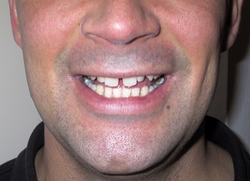This article may need to be rewritten to comply with Wikipedia's quality standards, as Page fails to meet Wikipedia formatting standards; a majority of cited sources are not very relevant to the article's content, which is a specific genetic disorder.(August 2025) |
| Schmitt Gillenwater Kelly syndrome | |
|---|---|
| Other names | Radial hypoplasia-triphalangeal thumbs-hypospadias-maxillary diastema syndrome |
 | |
| Schmitt Gillenwater Kelly syndrome has an autosomal dominant pattern of inheritance. | |
Schmitt Gillenwater Kelly syndrome is a rare autosomal dominant [1] congenital disorder consisting of radial hypoplasia, triphalangeal thumbs, hypospadias, and maxillary diastema. [1] [2]
Contents
- Discovery
- Radial hypoplasia
- Signs and symptoms
- Causes
- Treatment and prognosis
- Triphalangeal thumbs
- Signs and symptoms 2
- Causes 2
- Treatment and prognosis 2
- Hypospadia
- Signs and symptoms 3
- Causes 3
- Treatment and prognosis 3
- Maxillary diastema
- Signs and symptoms 4
- Causes 4
- Treatment and prognosis 4
- Similar diseases
- References
- External links


